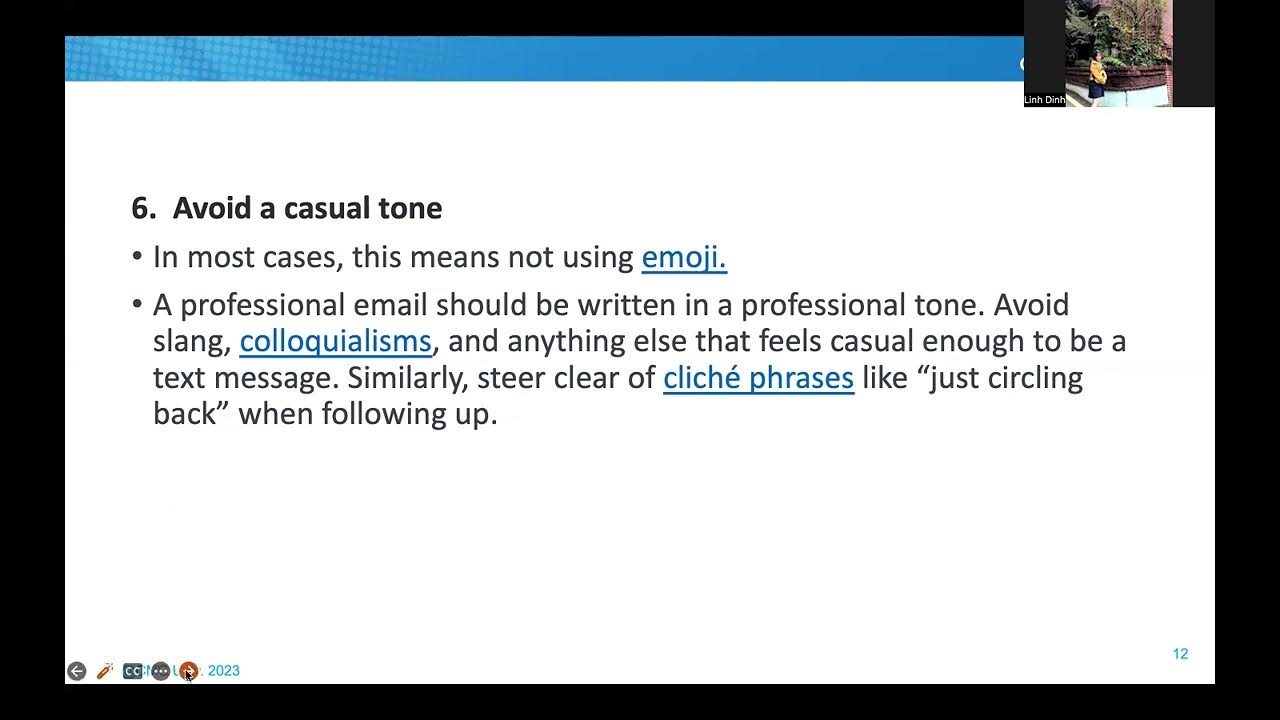Business English: Business Letter Writing
Summary
TLDRThis video lesson focuses on the essentials of writing formal letters in English, tailored for business communication. It outlines key components, including appropriate salutations, clear introductions, conveying good or bad news, and concluding remarks that indicate next actions. The video provides practical examples for each section, encouraging learners to engage with interactive exercises. By emphasizing clarity and structure, this lesson aims to enhance writing skills for effective professional correspondence, making it a valuable resource for those looking to improve their business English.
Takeaways
- 😀 Start business letters with a proper salutation, using 'Dear' followed by the recipient's title and name.
- ✍️ Clearly state your reason for writing in the introduction to provide context.
- 📢 Use specific phrases like 'I am writing to tell you about...' or 'I am writing to confirm...' for clarity.
- 🎉 When delivering good news, phrase it positively, such as 'We are pleased to announce...'.
- 😞 For bad news, be direct but respectful, e.g., 'We have decided to work with a different provider...'.
- 🔍 In the conclusion, specify the next action you expect from the recipient, like 'I’d appreciate your immediate attention...'.
- 📩 End your letter with a formal closing, such as 'Respectfully yours' or 'Warm regards'.
- 📝 Practice makes perfect; engage in exercises to reinforce your understanding of letter writing.
- 🔄 Use practice questions to test knowledge of proper letter formats and content structure.
- 🌐 Visit resources like onestepenglish.com for more lessons and practice opportunities.
Q & A
What is the first step in writing a letter according to the script?
-The first step is to open the letter with 'Dear' followed by a name, such as 'Dear Mr. Smith' or 'Dear Dr. Myers'.
What are some reasons for writing a letter mentioned in the script?
-Reasons for writing a letter can include informing someone about a new product or confirming attendance at an event.
How should one express good news in a letter?
-Good news can be expressed by stating, 'We are pleased to announce that our company has agreed to sponsor your event.'
What is an example of conveying bad news in a letter?
-An example of bad news is saying, 'After careful consideration, we have decided to work with a different provider for our materials.'
What should be included in the conclusion of a letter?
-In the conclusion, you should indicate the next action you want the recipient to take, such as 'I'd appreciate your immediate attention to this matter.'
What are some suggested closings for a letter?
-Suggested closings include 'Respectfully yours, Jason Mendoza' or 'Warm regards, Monica Williams.'
What is a correct example of a salutation?
-A correct salutation is 'Dear Mr. Smith.'
How do you express anticipation for a response in a letter?
-You can express anticipation by saying, 'I look forward to hearing from you.'
What is the significance of stating the reason for writing in the letter?
-Stating the reason for writing helps to provide context and clarity for the recipient, making the letter's purpose clear.
Why is it important to have a clear structure when writing a letter?
-Having a clear structure helps the recipient understand the main points easily, ensuring effective communication and a professional tone.
Outlines

Dieser Bereich ist nur für Premium-Benutzer verfügbar. Bitte führen Sie ein Upgrade durch, um auf diesen Abschnitt zuzugreifen.
Upgrade durchführenMindmap

Dieser Bereich ist nur für Premium-Benutzer verfügbar. Bitte führen Sie ein Upgrade durch, um auf diesen Abschnitt zuzugreifen.
Upgrade durchführenKeywords

Dieser Bereich ist nur für Premium-Benutzer verfügbar. Bitte führen Sie ein Upgrade durch, um auf diesen Abschnitt zuzugreifen.
Upgrade durchführenHighlights

Dieser Bereich ist nur für Premium-Benutzer verfügbar. Bitte führen Sie ein Upgrade durch, um auf diesen Abschnitt zuzugreifen.
Upgrade durchführenTranscripts

Dieser Bereich ist nur für Premium-Benutzer verfügbar. Bitte führen Sie ein Upgrade durch, um auf diesen Abschnitt zuzugreifen.
Upgrade durchführenWeitere ähnliche Videos ansehen

(LEVEL 6-EPS 2): WRITING SKILLS: Formal email

Komunikasi Bisnis - Direct Request dan Korespondensi Bisnis

CARA MENULIS SURAT DINAS YANG BENAR | HINDARI Penulisan Ini di Surat Dinas

SURAT RESMI DAN SURAT PRIBADI | PEMBELAJARAN BAHASA INDONESIA KELAS VII SMP BAB 6 KURIKULUM MERDEKA

Ada berapa jenis surat? | Bedanya Surat Formal, Informal, Surat Resmi, dan Surat Bisnis!

Types of Business Letters
5.0 / 5 (0 votes)
